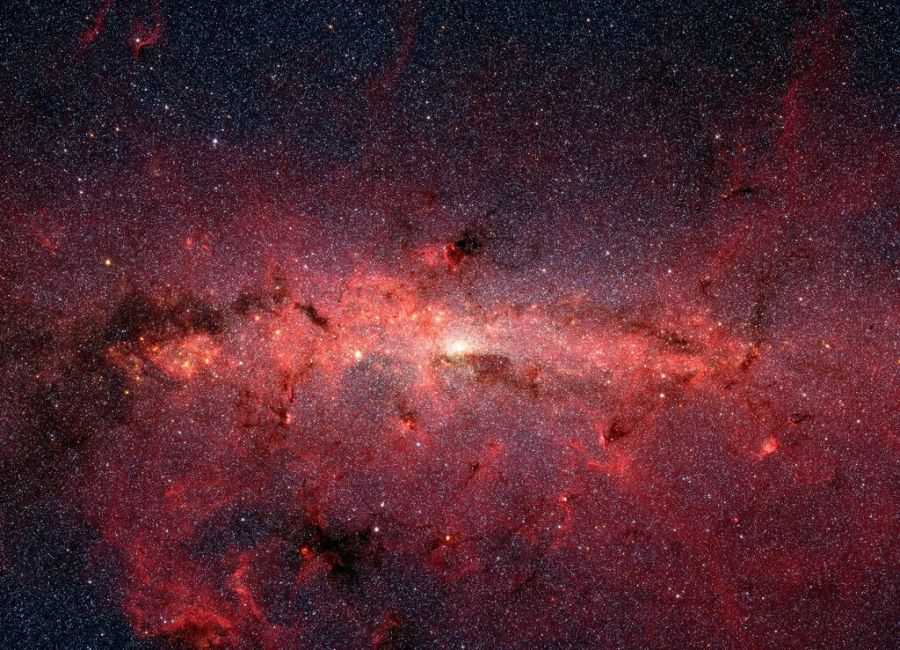Cosmology, Baryonic and Tachyon Matters:
In development . . .

This image is the starry core of our spiral Milky Way galaxy, in an infrared image from NASA Spitzer Space Telescope. Obscured behind it is the South Pole Wall, a curtain of thousands of galaxies across at least 700 million light-years. Credit: NASA
-----------------------------------------------------------------------------------------------------------------------------The Age of Universe:
Me found that Age of Universe is 311 trillion yearsAccording to modern concepts, according to the LambdaCDM model, the age of the Universe is 13.799 billion years (22,000 times less!)
-----------------------------------------------------------------------------------------------------------------------------
Tachyons:
Tachyons: particles which speed more speed of lightBradyons = particles which speed less preed of light
The energy_momentum relation:
E^{2}=(pc)^2+(mc^{2})^2
(where p is the relativistic momentum of the and m is its rest mass) should still apply, along with the formula for the total energy of a particle
E= mc^2/sqrt(1- v^2/c^2)
This equation shows that the total energy of a particle (bradyon or tachyon) contains a contribution from its rest mass (the "rest mass–energy") and a contribution from its motion, the kinetic energy. When v (the particle's velocity) is larger than c (the speed of light), the denominator in the equation for the energy is imaginary, as the value under the square root is negative. Because the total energy of the particle must be real (and not a complex or imaginary number) in order to have any practical meaning as a measurement, the numerator must also be imaginary: i.e. the rest mass m must be imaginary, as a pure imaginary number divided by another pure imaginary number is a real number.
The speed of a tachyon increases as its energy decreases.
-----------------------------------------------------------------------------------------------------------------------------
Our Model for the Development of the Universe:
It consists of Three Components:- Radiation,
- Baryonic matter, also called Visible matter
consists of baryons (an overarching name for subatomic particles such as protons, neutrons and electrons)
- "Dark matter" (tachyons and anti-tachyons)
Our Hypothesis: Dark matter consists of tachyons and anti-tachyons. The correct name for it is Tachyon Matter.
After the "Big Bang" there is a massive release of tachyons, which scatter in 3-dimensional space (expansion of the Universe). When they collide with each other, they turn into baryons (protons).
Protons are attracted to each other and form galaxies. Black Holes are formed in galaxies, where the baryonic matter of galaxies is drawn into.
As a result, tachyons burn out, concentrating in the cores of stars, and baryons go into black holes. As a result, the universe disappears.
Somewhere these protons (understand where!) turn into tachyons. A new Big Bang is happening. A new universe appears. And so on (the cycle of creation-disappearance of the Universes).
T - time between two consecutive Big Bangs
T_Universe - time of Universe life
T_Dark - time between disappering of one Universe and Big Band of next one
T = T_Universe + T_Dark
T_Universe is the same for all Universes
T_Dark iz also the same
Problem:
How to send information from current Universe to the next Universe?
Problem:
It is obvious that there was the very first Universe, before which there was nothing. What order is our Universe?
-----------------------------------------------------------------------------------------------------------------------------
The Sun Time Life estimation Algorithm:
Solar constant S0 is the average amount of radiant energy received by the earth's atmosphere from the sun.
S0 = 1367 watt/sq.meter
Radiation energy from the Sun ejected per 1 sec RE = 4* pi * R^2 * S0 where R is the distance between the Sun and the Earth
RE in kinograms (Sun Radiation Energy SRE) = RE / c^2 = 3.845 * 10^26 kg/sec
Total mass of the Sun = (mass which transformed to He4) + (mass burned to energy)
mass burned to energy = (Proton Mass of the Sun) * (defect of the mass)
Defect of th mass = (1-4.0026/(4*1.007276)) = (1 - 0.974248)
Timelife of the Sun = (mass burned to energy) / SRE = 0.38 * 10^4 sec
Result: The Sun Time Life equals 63.3 minutes!
Question: why are we still alive?
Answer: because of tachyon matter existance in our Sun and its burning in it!
The universe is filled with gas of tachyons. But unlike protons, they do not concentrate into clusters. When they fly near the Star, they are drawn into its Core. Accordingly, their concentration in the Nucleus increases, as a result they collide with each other, creating "hot" protons. That is, they add new protons to the Core, which leads to an increase in the burning time of the star. This is why our Sun burns much longer.-----------------------------------------------------------------------------------------------------------------------------
Time-variation of fundamental constants:
Gravitational constant
Weak interaction constants (matrices)
The fine structure constant characterizes the strength of the electromagnetic interaction.
Strong interaction constants (???)
Immediately after the Big Bang, the Gravitational Constant and the Fine Structure Constant are equal to one in a dimensionless system of units. They will become equal to zero at the end of the existence of the Universe.
In development . . .
-----------------------------------------------------------------------------------------------------------------------------Current Time of the Universe T_now:
We calculate this time through the Fine Structure Constant equal to 1/137.T_now= AgeOfUniverse * ( 1 - Fine Structure Constant ) =
311 trillion years * ( 1- 1/137 ) =
308.7 trillion years
-----------------------------------------------------------------------------------------------------------------------------
Initial value of Gravitational Constant G_0 in SI system of Units:
In development . . .
-----------------------------------------------------------------------------------------------------------------------------Spiral recession of galaxies as a result of the reduction of the gravitational constant :